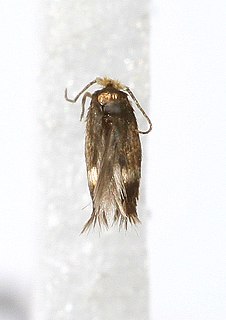| Monochroa robusta | |
|---|---|
| Scientific classification | |
| Kingdom: | Animalia |
| Phylum: | Arthropoda |
| Class: | Insecta |
| Order: | Lepidoptera |
| Family: | Gelechiidae |
| Genus: | Monochroa |
| Species: | M. robusta |
| Binomial name | |
| Monochroa robusta (Braun, 1921) | |
| Synonyms | |
| |
Monochroa robusta is a moth of the family Gelechiidae. It was described by Annette Frances Braun in 1921. It is found in North America, where it has been recorded from Ohio and South Carolina. [1] [2]

Moths comprise a group of insects related to butterflies, belonging to the order Lepidoptera. Most lepidopterans are moths, and there are thought to be approximately 160,000 species of moth, many of which have yet to be described. Most species of moth are nocturnal, but there are also crepuscular and diurnal species.

The Gelechiidae are a family of moths commonly referred to as twirler moths or gelechiid moths. They are the namesake family of the huge and little-studied superfamily Gelechioidea, and the family's taxonomy has been subject to considerable dispute. These are generally very small moths with narrow, fringed wings. The larvae of most species feed internally on various parts of their host plants, sometimes causing galls. Douglas-fir (Pseudotsuga) is a host plant common to many species of the family, particularly of the genus Chionodes, which as a result is more diverse in North America than usual for Gelechioidea.

Annette Frances Braun (1884–1978) was an American entomologist and leading authority on microlepidoptera, kinds of moths. Her special interest was moths whose larvae live as leaf miners.
The wingspan is 11–12 mm. The forewings are dull ocherous, rather densely overlaid with purplish fuscous dusting, especially toward the apex, where it obscures the ground color. Before the middle of the wing and the beginning within the costa, a darker shade crosses the wing very obliquely to the fold where it spreads out, rarely reaching the dorsal margin near the tornus. At two-thirds a not very oblique yellowish costal streak passes to the middle of the wing just beyond the rather elongate black spot at the end of the cell. A dark line at the base of the cilia is broken on the costa by four faint ocherous spots and similar pale spots are sometimes visible along the termen. The hindwings are fuscous.

The wingspan of a bird or an airplane is the distance from one wingtip to the other wingtip. For example, the Boeing 777-200 has a wingspan of 60.93 metres, and a wandering albatross caught in 1965 had a wingspan of 3.63 metres, the official record for a living bird. The term wingspan, more technically extent, is also used for other winged animals such as pterosaurs, bats, insects, etc., and other fixed-wing aircraft such as ornithopters. In humans, the term wingspan also refers to the arm span, which is distance between the length from one end of an individual's arms to the other when raised parallel to the ground at shoulder height at a 90º angle. Former professional basketball player Manute Bol stands at 7 ft 7 in (2.31 m) and owns one of the largest wingspans at 8 ft 6 in (2.59 m).
The larvae feed on Scirpus atrovirens . They mine the leaves of their host plant. The mine extends toward the tip of the leaf, beginning as a small transparent blotch, with an opening on the underside of the leaf. Following this is a linear green portion with sides nearly parallel, in which the leaf substance is not eaten. Beyond this, the mine expands and becomes larger and semi-transparent. When ready to pupate, the larva leaves the mine through a circular hole in the upperside of the linear green portion. The larvae are whitish with a black head. [3]

A leaf miner is the larva of an insect that lives in and eats the leaf tissue of plants. The vast majority of leaf-mining insects are moths (Lepidoptera), sawflies and flies (Diptera), though some beetles also exhibit this behavior.





